It’s that time of year; weather is warming up, and thunderstorm activity is heating up as sailing club, school and rental activity opens up. We revisit this topic every year as a public service. One reason: people still don’t seem to ‘get it.’
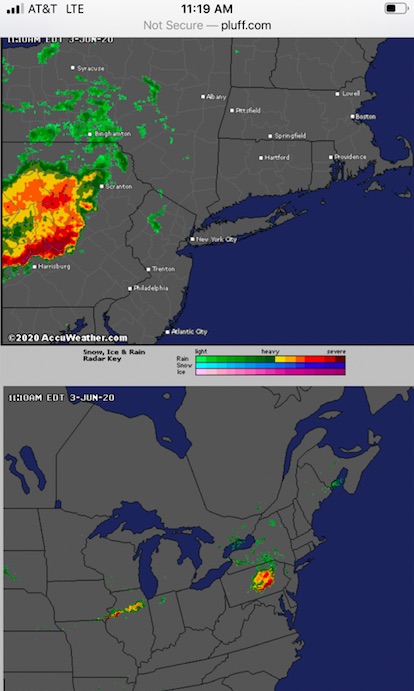
In that pic: screen capture of radar images on Wednesday, June 3, in the late AM. We had a private lesson booked that day with an experienced sailor. The forecast was for thunderstorms – not a chance, or a likelihood, but just… thunderstorms. And, they warned of potentially damaging winds and hail. Not a garden variety summer forecast, which is “chance of showers and thunderstorms” or similar language.
Oh, no… it’s ON!!!!
Below, I’ll share how the day of June 3 unfolded forecast wise, and also stories about two needless tragedies in the past that happened when people didn’t pay attention to the forecast.
The first step of the day is to check the forecast. That should be done several times as the day progresses to look for updates. The next step is to check the radar. Easier than you might think; just look at the pic above. Pretty clear that something is brewing. And, even if the forecast winds up being off, the radar doesn’t lie. It doesn’t take a meteorological degree to read a radar app. It just takes a little time and experience.
On two occasions since I’ve been operating New York Sailing Center, which I founded in the fall of 1997, there were particularly violent thunderstorm systems that passed through the region and resulted in a fatality at some other school/club. NOT AT MY SCHOOL/CLUB. At others.
The first was in 1998, before we all had smart phones and radar apps at our disposal. It was old school; check the forecast, check the sky, and listen to the VHF radio weather band for updates. The forecast was doom n gloom: thunderstorms, some of which could be severe, and which had a large outer perimeter of strong wind (meaning no way to see it coming). And, the storms had already started upstate and killed a few people.
Make no mistake; winter is coming…
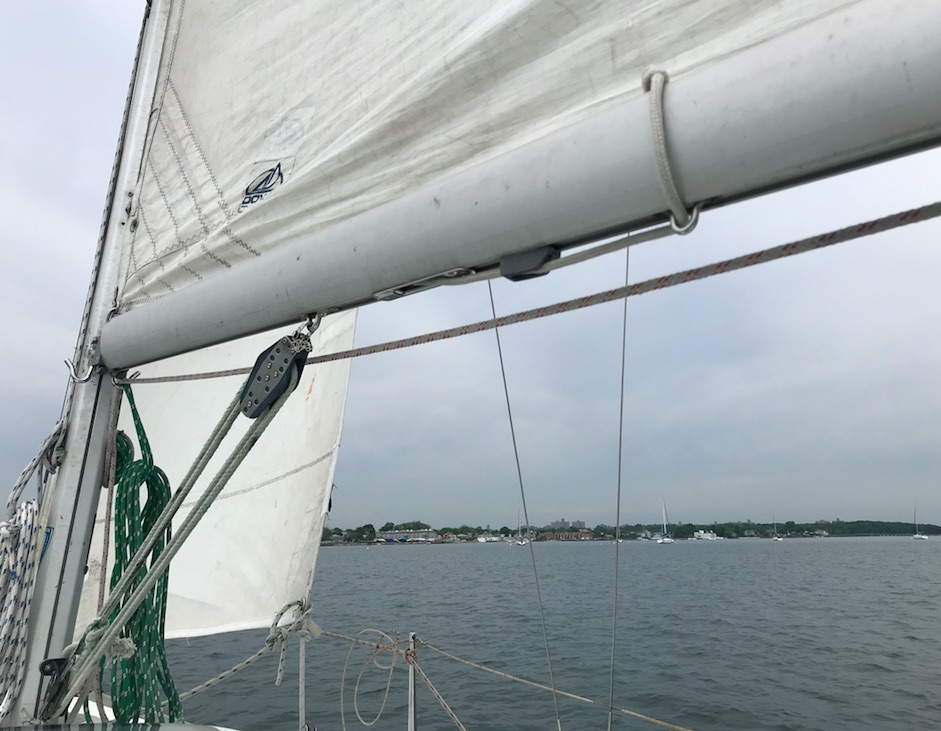
So, I kept everything on a super tight leash that day in 1998. We had one class with a veteran instructor. We talked about it and decided to confine the boat to the anchorage. No further than the outskirts of the anchorage. The anchorage is small. More maneuvering, then! Marina customers were warned of the storms if they showed up. A few did and just turned around and went home. One woman chose to sit on her boat at the mooring for awhile and then go home.
Eventually, after frequently checking the sky to the north and west, I didn’t like the look and feel. I started radioing the instructor to come in, and saw he was already approaching the mooring. They took one shot, and fell short… and then it hit. BAM. Nothing to be seen in advance. Just wind laying the boat over and flogging the sails. They didn’t have a chance to sail back to the mooring; no way. The boat was basically blown down onto the next pier, and the instructor wisely off-loaded the students and left the boat. I went out with a few experienced people and two solid motor boats, and towed the sailboat off and moored it. It took two boats just to pull it off and suspend it into the winds, which were at least 60 knots and possibly as much as 70. When it subsided a bit, we moored the boat.
It was over quickly. It always is. But it takes little time to cause mayhem. We got away with a torn sail and a fright. Down in New York Harbor, they weren’t so lucky. One large club/school had allowed at least one member to go out with his family. The boat took a complete knockdown, and the man was in the water and separated from his family. He wasn’t wearing a PFD. His body was found a few days later in Gravesend Bay, Brooklyn.
Fast forward to August, 2010. Morning forecast: about the same as the 1998 incident. Thunderstorms. Severe. Moving fast. Clear band of strong winds. This time, however, we had smart phones and radar.
I kept the one class we had that day pretty close for our morning sail. I intended to do a short n sweet lesson, get off the water way early, and watch it all blow through during lunch and some extra classroom. While on the water, I got a call from a recent graduate hoping to come out for one of his practice sails that afternoon. Sorry; no. Bad forecast. He pushed; I explained the severity of the forecast. He tried some more.
“No fucking way! I’m not going to let you come out here just to die in some violent thunderstorm! You’ll come out another time – live to sail another day!” The first sentence is an exact quote; the second is approximate. The message is clear.
What happened then? We sailed back to be safe. Sky still looked fine. Checked the update radar while waiting for our launch ride. Whoah…. it was the largest Darth Vadar Death-Star-looking doom ‘n gloom ball of red, orange and yellow I’d ever seen – before or since – on a radar screen. It was moving south and clearly going to hit all of Western New Jersey, Westchester, NYC, and Nassau, Long Island. All of it; all at once.
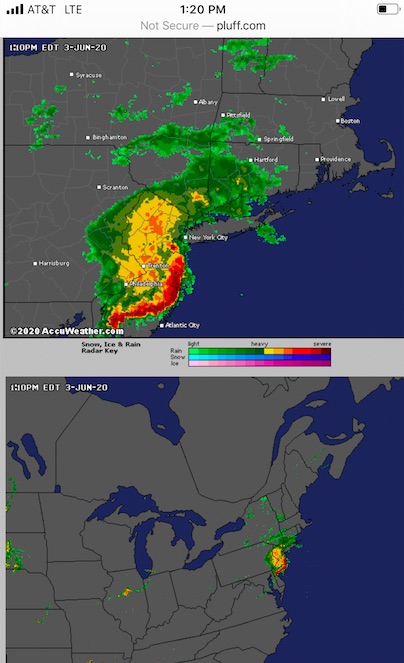
So, I shut down the operation until further notice. Told my launch operator to go somewhere inside for lunch on the avenue and stay there until I told him to return. I took my class to do the same, with some classroom props.
It did hit. We were basically done with lunch and b.s.-ing about other stuff. Suddenly, it was very dark. Stuff was flying around like that scene from the Wizard of Oz. Darker; windier. Eerily, we couldn’t really hear it as the place was well sound insulated and we were in the back looking down the hall at the front door. And, almost as soon as it started, it was over.
We paid up and walked back to the marina. None of us had ever seen so much random debris blown around by a squall. The waterfront was worse; the waterway itself was a shit show of stuff blown offshore by the storm. There was zero wind. Sun was back out. Surreal.
And then, I got a text from one of my instructors. He let me know that another school (again, not ours) had a class out during the storm. They lost one person. Literally. The body was found a day or two later. This was disturbingly close to home, in lower Westchester, within sight of my school on a clear day. it was day one of a learn to sail course (compared to day 3 for mine that day). They went out in the afternoon (as opposed to my coming in at around mid-day). No one aboard was wearing a life jacket, or PFD. (We spend extra money on comfortable automatic inflatables with manual overrides, and make people wear them.) The boat had no lifelines, which are wires or ropes that are elevated above the deck going around the boat. (Not all boat designs have them, but it’s riskier when they don’t – especially for beginners.) Everyone on that boat wound up in the water; all but one made it back to the boat.
All but one.
I knew several sailors who got caught out in that same storm. They all fared well, but got quite a fright. I heard of others who got caught as well (also survived). The common denominator? And, what was reported in the news regarding the fatality in Westchester?
“It happened so fast.” “You couldn’t see it coming.”
But, you could. On the bloody radar! And, you KNEW it was coming. Why wait to see it? Does that sound simplistic? Well, it really is that simple.
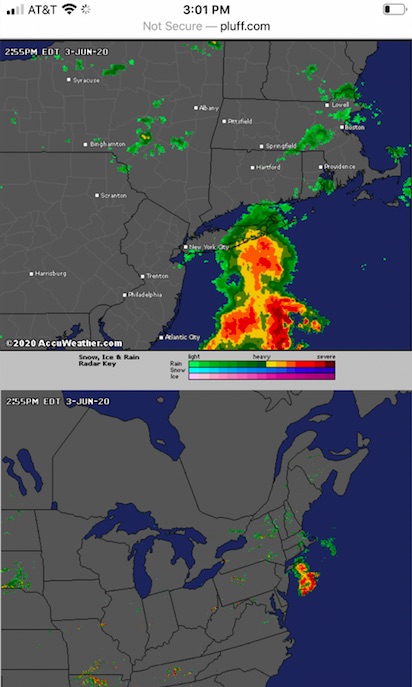
In that pic: all gone – out to sea, but I pity the fool who got caught out in that. It intensified as it neared shore and got over the water. Wednesday, June 3.
Remember the DUCK boat incident a few years ago? We did a blog rant about that. Same shit; different details. Only that time, many people died. I’ll link back to that blog post below.
The lesson: people don’t seem to learn the lesson. Here’s how I suggest you manage the risk of getting caught in a squall or thunderstorm on the water during the summer, which is when most of them happen, and also when most of you would likely do most of your boating.
- start the day with the forecast online, cross referencing at least two sources.
- If there’s some risk of thunderstorms, consider skipping boating that day.
- If you go anyway, check the update forecast upon arrival at the marina.
- Start checking the radar at that time as well. If it looks dicey, don’t go!
- If it looks like it’s far off, or just not developed, stay close and check frequently – at least every 20′.
- As soon as it’s looking worse, assume the worst. Head back. If you have an engine, turn it back on (yes, you should have checked it before). Stow sails.
- Moor or dock the boat. Double check the radar and forecast.
- If still no good go home! If the risk went away, it’s your call.
I’m not a meteorologist. I’m not a weather forecaster. I’m not a climate scientist (although I know one who’s a PhD candidate at Columbia). But, I am an expert and well-seasoned mariner. And, I have to make decisions all season that affect other people: whether they get to play or not that day. it comes down to whether they’re safe or at risk of death. And so, I check the weather and radar pretty obsessively.
“What do we say to the God of Death?”
“Not today.”
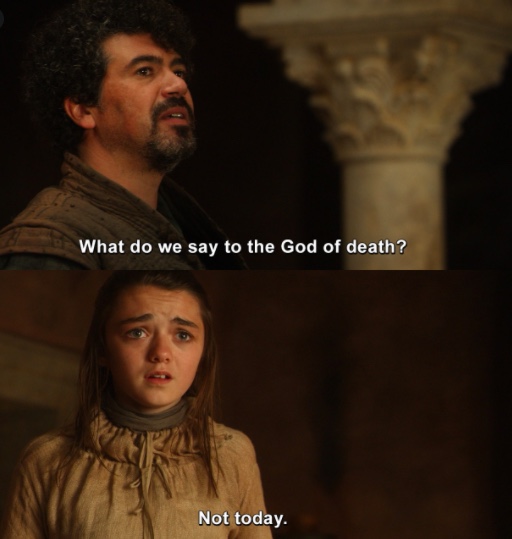
Arya was bad-ass enough to slay the Night King. But even she knew the universal truth:
“Don’t f*%! with Mother Nature!”
RESOURCES:
The Radar web site (not an app per se) that I like to use for the northeast…
Our Blog Rant about the DUCK boat tragedy…